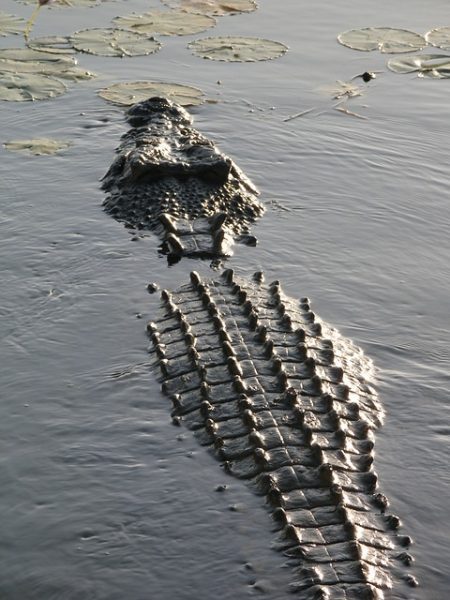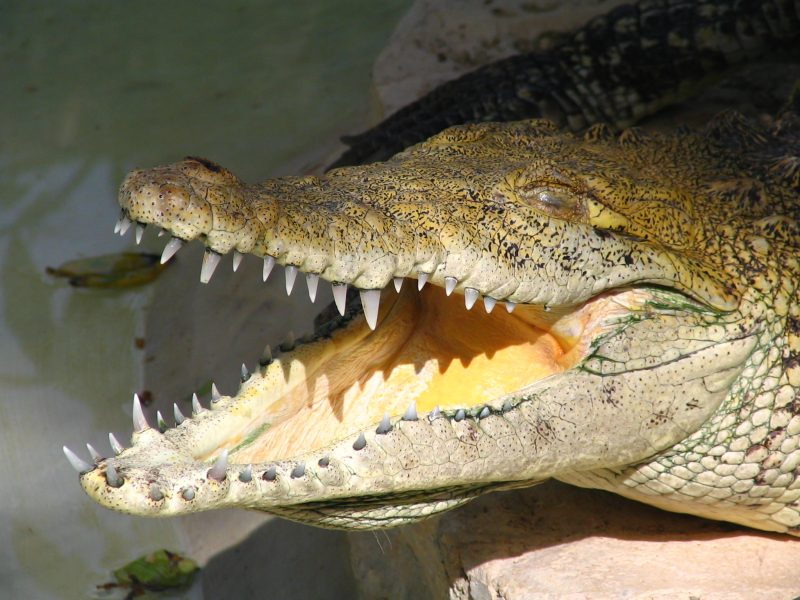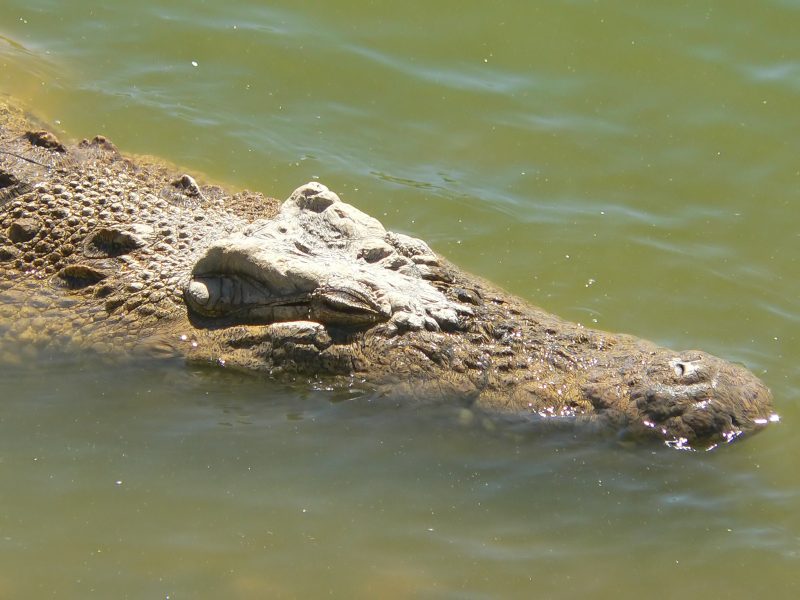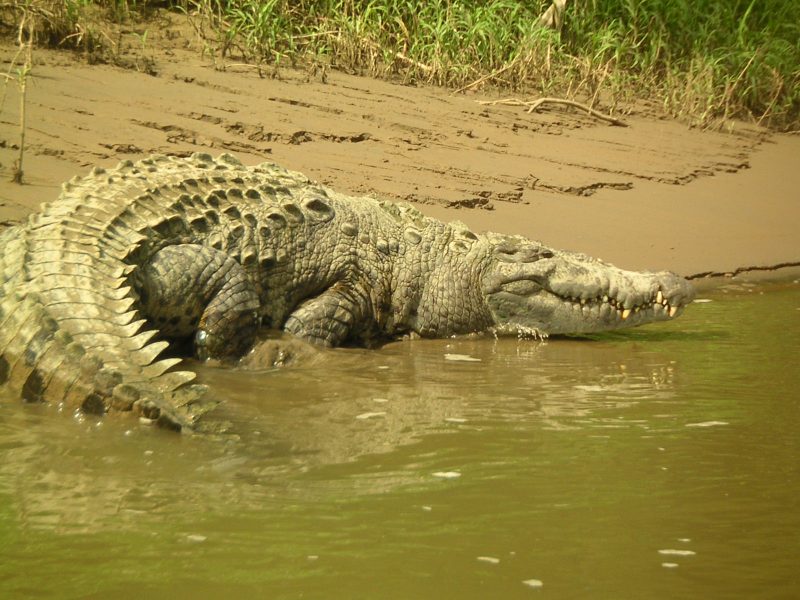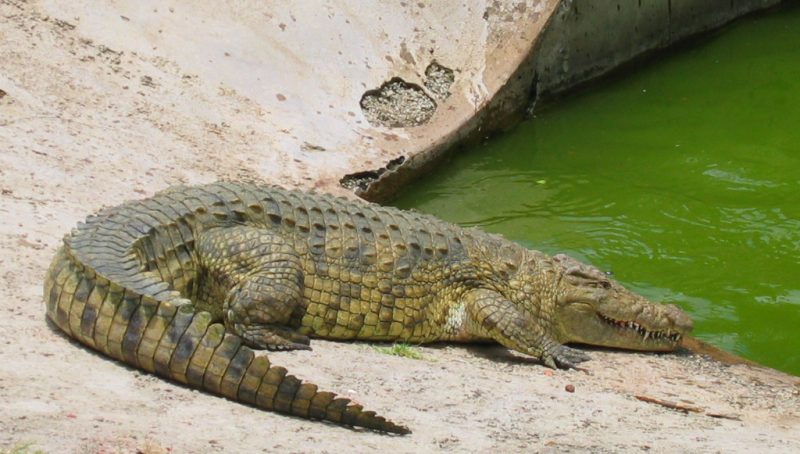Travel To Kenya To Get To Know The Crocodiles
Natural habitat range
Nile crocodile is 1 of the 3 species that occur in Africa. It is widespread throughout sub-Saharan Africa, the Nile Basin, Madagascar as well as Southern Africa including Botswana, Namibia, Zimbabwe and Zambia. There is also a healthy numbers of them in many East African countries such as Ethiopia, Somalia, Kenya, Uganda and Tanzania. It inhabits many types of water bodies such as wetlands, inlets, lakes, large rivers, mangrove swamps and freshwater marshes. Ages ago, the range stretched far northward and even as far as Israel. They are hole-nesters with preferred nesting sites being sandy shores, riverbanks and dry stream beds. There are about 450,000 of them in the wild.
Features
The main features of Nile crocodile are 4 short legs with hind feet, a body with scaly hide, a strong flat tail and a strong jaw. But its main feature is the large tooth on the lower jaw, which juts out when from its mouth. It has a purple under part and a bronze colored back. The flanks are yellow in color and scutes form on the tail and back. The colors change, as it grows old.
Vital figures
A male crocodile can weigh well over 1,650 pounds and reach a size of about 20ft in length. But the normal size is more in the range of 500 pounds and 16 feet. It reaches a usual length of 5m and weighs up to 410kg. But, they can also measure 6m in length and 900kg in weight.
Growing up
In the wild, both male and female crocodiles reach sexual age at 12. The onset of youth in males occurs at 3m length and 200kg of body mass and females attain it at 2.5m length and 150kg body weight. Girls start mating as soon as they reach this age. But males only begin mating at the age of 15 and when they are 4m long with a body mass of 400kg.
Parent-hood
Females tend to make their nests very close to each other. They dig holes 50cm deep a few meters away from the bank and lay up to 90 eggs. She covers the eggs with sand and guards them for an hatching period of three months. One special trait of this fearsome reptile is its caring parent-hood. Where most reptiles move on after laying eggs, Nile crocs fiercely guard them until fully hatched. They often roll the eggs in their mouths to help babies emerge. The mother protects the newborns for about 10 days. She may form a crèche in the area. The babies grow to 1.2m long by the time they reach 2 years and leave the nest area. But only 2% of them survive to live beyond 1.5m in length. After that, the death rate drops as the adult has few foes besides humans.
Social system
Although crocodiles are scary creatures, they are fun animals. Their group system and adult manner are often fun and cheerful to watch to both the biologists and the general public. People call the clusters in the water floats. Group size may contain up to 100 individuals and depends on the abundance of food. Sometimes they hunt cooperatively, but the largest crocs eat first. On hot days, Nile crocodile spends much of the day ashore to bask and warm itself in the sun. They lounge with their mouths open. Both sexes gather at basking sites. When they bask on the riverbed, the older males defend the territories along shorelines. In accordance with the chain of command, the males occupy the best spots. When the surface water dries up or when food resources are scarce, groups tend to break up. Individuals in groups communicate with pitched vocals. They use a range of hisses and calls. They love body contact and often lie over or against each other.
Hibernation
A crocodile may enter hibernation during drought periods, which can last for many months at a stretch. They dig a hole in a dry river bank or river bed and retreat into it. Those in these dens can survive without food for up to 2 years. When searching for other food, they can migrate many miles across dry land.
Body heat
Their body heat of crocs is not constant. The core warmth is about 38°C by lounging in the sun during daytime. After sunset, the heat soon drops to 15°C. They use the energy for mingling, hunting and digestion. Without enough heat, it cannot digest food. For this reason, in a long period of cold, the undigested and rotten food contents in the stomach may become poisoned. Also, the gender of the hatchlings is subject to heat, which means the usual heat during hatching period decides the gender.
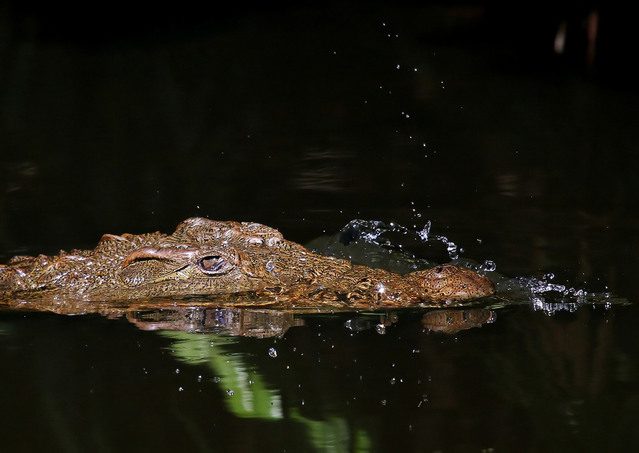
Travel to Kenya to get to know the crocodiles
Motion under water
Nile croc is very much an adapted marine creature. Its most vital and usual method of movement is swimming. On land, it is very stiff and awkward and stick out like sore thumb as they are very alert and move only when needed such as when feeling threatened by scary objects. But in the water, they are way too easygoing, often hiding and always running about. They have the skill to swim smoothly at high speed and with strong agility. Interestingly, although they move around deep under the water they do not seem to have the usual features allied with swimming. Hence, people often wonder how crocs that do not have fins or gills like other water beings, spend almost their entire lives in the water. After many years of close tests and studies using the right tool that can pierce the vision under water, biologists and scientists reveal the fun ways in which they transport themselves from 1 place to another in the water. As is always the case with any living organism, the growth of almost 50 million years did play the most crucial role in helping their main body organs adapt to swimming means.
Swimming style
While swimming, crocodile uses its tail as well as front and back legs. Its place in the water depends on its weight and the amount of breathing air in the lungs. To drift on the surface of the water and prevent sinking, it has to counter balance its weight. It does this by storing a certain amount of air in its lungs. The right measure of breath in the lungs stops the reptile from sinking and averts it from rolling in the water in an awkward manner. So, it is the air in its lungs that they use for keeping it afloat. In this place, its head is at the edge of the water, and the body is downwards a few inches below. It has a long snout with crescent-shaped nostrils at the end of it. It can only breathe when they expose these nostrils in the air. And its snouts are indeed in such a shape that it can it almost fully dips it under water and still breathes. When it dives, it exhales enough air from the lungs and descends under the water. The speed of the drop depends on the volume of the exhaled air. Also, it sometimes swallows large boulders, and they lie in the stomach. These stones in the stomach help to act as ballast by adding weight.
Function of organs
With their strong tail, strong jaws and sharp teeth, crocodiles are quick to attack as they can move swiftly through water. When it floats on the surface of the water, it uses its tail to maintain its place in flowing water. The flat tail gives it a much large area and all the thrust it needs as it moves against the force of the water. Also, like the fish fins, they splay out their limbs i.e. the back and front legs, to each side as stabilisers. Webbing between the back feet toes gives surface area and they used them as a support by pushing against the running water, and even to move slowly. For steering the move, it often points its face in the course that it is going and splays its limbs out to aid in the movement. It can swim at a speed of 10 to 15kph at the most, which might not sound fast. But the good thing is that it needs far less vim amount and hence can sustain the swimming for a long period of time. Few large animals, notably those more used to land movement, can escape from these large reptiles swimming at full speed.
Shifting diet
Crocodiles are meat eaters, and they eat only meat and often feed on animals but sometimes even their own. They may look sluggish and slow while not moving. But it is one of the most potent and strongest natural meat-eating killer changes as they age and as the size of its body grows. And what transforms with that is its food hunting manner. They have many items included in their diet as they age. The hatchlings, i.e. the young ones, feed on insects, snails, spiders, gastropods and mussels as well as all kinds of shell fishes and amphibians. The youth feed mostly on frogs, toads and small fish such as bass, catfish, tilapia and labeo. The sub-adults feed on reptiles such as terrapins, snakes, pythons, water birds, rodents and crabs. As they grow into adults, they eat turtles, small mammals and birds that include storks. But with old age, the diet changes even further. A fully-grown up mature adult will pull any big animal such as gazelle, monkey, hippo, warthog, hyena, baboon, impala, wildebeest, antelope, buffalo, giraffe, elephant and zebra beneath the water. It can leap up to catch nesting birds and attack any of those big mammals. Although they prefer fresh food it can even scavenge carrion and eat rotting bodies, unlike other killers that only eat fresh meat.
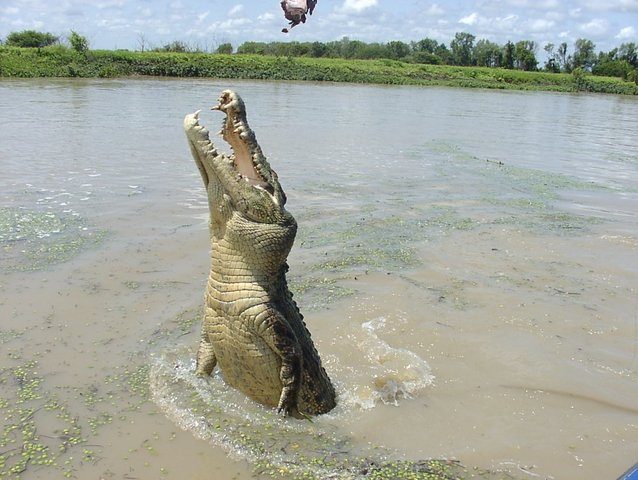
Travel to Kenya to get to know the crocodiles
Preying
On normal days, crocodiles hide in the water and slowly wait for its prey. It’s olive colouring aids in hiding. The eyes, nostrils and ears are on top of the head, which allows it to lie flat in water that helps it to them from its prey. It has small bumps as integumentary sensory organs in the scales of its jaw, face and body, which they used to detect echos and movement in the water. These organs are so subtle that they allow them to detect even the slightest movements as well as heat and chemical changes in the water. Also, they also have excellent night vision and a good sense of smell. It uses this radar system and facial features along with its 68 teeth to its gain when aiming at a victim. When they target the prey, they hide in the water. Interestingly, when threatened, they can hold their breath and stay under water for up to 2 hours. This skill allows them to target and follow the prey disguised for hours, days or even weeks. Then it ambushes and attacks at the right moment jumping up into action making sure that it is swift and able. And then the assault on the victim is ruthless.
Raiding the victim
When something nears the water hole, the crocodile will launch itself forward in a lightning attack. It exerts strong pressure using its massive jaws while clamping and holding onto their prey. Like other crocodilians, it can bite but cannot chew or break off small pieces when hunting larger animals. As a result, it dives and drags its poor prey under water. A valve in the throat allows it to keep its mouth ajar and hold the victim under water without water entering its throat. It then kills it by drowning or crushing it. First, they sink their teeth into the flesh. Sometimes you can hear their bones breaking due to the power of it. It then surfaces briefly still grasping flesh. By then the victim would have died a awful death. Then using a twirling method, it tears off large flesh chunks and swallows them whole. This twirling method is called death roll, which involves jerking the head briskly, or twisting or spinning on its axis in the water to pull the meat off the prey. Groups of crocs use each other for support to perform these during a kill. The best time and place to watch this is from July to October in Maasai Mara as millions of zebras and gazelles cross Talek and Mara rivers when entering Kenya.
Post-attack
When taking the carcass on the water’s edge, the croc raises its body’s fore quarters above the water surface and throws its entire body forward onto dry land. As crocs cannot swallow under water, they keep their head above the surface. They leave the prey to rot among tree roots or under banks until 1 of them dismembers it.
Digestion
After eating their meals, crocs swallow stones that grind the food in the stomach. It aids digestion. They have an ectothermic metabolism, which means slow breakdown. It allows them to survive long periods without food, but they can eat up to half their body mass. During summer an adult will consume once in 2 to 3 weeks. Sub-adults eat once a week, while babies eat daily. Their enzymatic gastral juices fully digest bones, hooves and feather. Interestingly, however, being poikilothermic beings, its food digestion is by the use of high heat.
Conflicts with human
The croc has earned itself a well-gained repute not only as a meat-eater but also as a vicious man-eater. The closeness of much of its abode to people and the almost random diet means crocs eat about 200 people each year. This hostile creature has caused many human-wildlife conflicts in these countries. They have attacked many hundreds of people who come to fetch water from the lake or river. Clearly, due to this, conflict with humans presents the greatest and the only threat. As a feral killer, people are often intolerant of them. For example, crocs come into conflict with fishers when trying to remove fish from the nets. Hence, killing of adult crocs in attack is common. It is a fun fact to note that the only threat to this feral killer lying low seeking out the poor victims is humans, who have strived hard and managed to increase its once dropping numbers well. But lower beings have no conscience or mind. Hence, humans are still an item in its list of diets and crocs continue to be a threat to people.
Hunting
The first record of the use of croc skin occurred in the US during the 1800s. Right after civil war, there was a huge demand for its leather, mainly for footwear. After world war 2 and during the later fiscal rebirth, demand for croc skin shot up further upwards. As demand surpassed supply and things became scarce, people in the US started reaping crocs. Meanwhile, in Africa, people began hunting Nile crocs in high numbers. Greedy poachers killed Nile crocs by hunting them not only for high-graded leather but also for its meat and alleged healing properties. This worldwide abuse went on well into the 1970s. The free hunting caused great havoc to its status and ended up in a severe dropping of their numbers. In some range, they are even close to extinction. It then became an risky species.
Fruitful saving efforts
People have put in laws in place to control commerce in wild species, and many countries followed suit to protect and lessen pressure on the reptiles. Also, it was a means to create rewards for croc savers to protect the species based on long term use. Oddly, abuse of crocs for skin and meat became a main tool in its saving effort. Thus the hunting ban brought on by global trade laws and nation wide laws as well as saving efforts such as croc saving programs have helped them rebound. These efforts have stopped the trade of crocs as well. This practice has helped boost its numbers as it improves its living rate and have ended up in a growth of the once exposed reptiles. Today, due to these saving efforts, they are safe. It is now a species of lower risk. Although now much ample and secure in Kenya, Nile croc numbers have dropped in some areas of its range in central and western Africa, not only due to banned hunting but also due to ongoing abode loss and pollution.
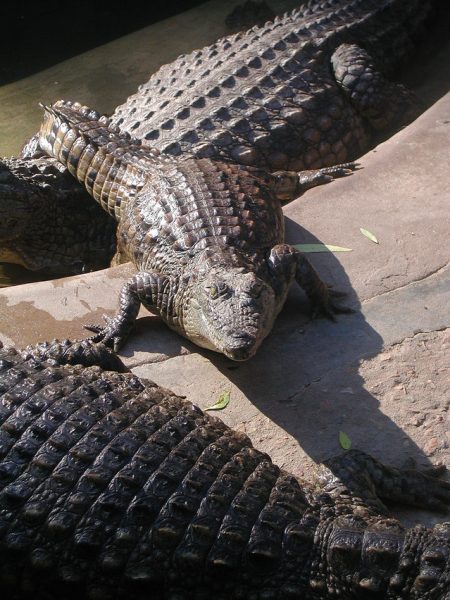
Travel to Kenya to get to know the crocodiles
Croc farming
Today, most global trade have banned croc products, with a provision for farming. With dropping numbers, the concept of croc farming started to take drive. The term croc farm or ranch describes any place that breeds crocs and grows them in a captivity for trade uses. They are sites where they exist safely without the threat of death from poachers. The Nile croc survives well in captivity. People farm them mainly for their skin to make high-graded leather. Ranching, wild harvest and captive breeding are the 3 production systems that apply to croc farming.
Farming model
Crocodile eggs and juveniles that have a low survival rate are available in the wild. And young hatchlings are available from existing farms. Farmers take these eggs and hatchlings from the mother crocodiles and rear them in captivity. Since mature females are capable of laying 70 eggs per season, it is highly advisable to gather as many of hatchlings and young juveniles as possible so the farm can use its maximum capacity. A proportion of it goes back to the wild.
Handle with care
Crocodiles are wild reptiles, and they require special care to survive in breeding conditions to minimize damage to the skin on its belly caused by social interactions or from the substrate surface. Reduce density as they become larger, to promote growth and to manage interactions between individuals. But most importantly they should be provided with enough food.
Crocodile farming in Kenya
Kenya is one of the countries in the world suitable for commercial crocodile farming. As part of the protection efforts, Kenya raises crocodiles in commercial ranches. The Mamba Village Resort in Nairobi is one of them. In Swahili, people call it mamba. The resort is about 13 km from Nairobi. This resort rears around 70 Nile crocodiles. The Southern and Eastern parts of Kenya provide the ideal conditions for crocodile farming. The best place for a crocodile farm is a flat terrain with high temperature. And such a land is cheaper to buy or lease. Today, successful sustainable-yield programs for ranching crocodiles for their skins exist not only in Kenya but also in countries with quotas.
Range of uses
People breed conventional animals for their meat with leather being a by-product, but they breed crocodiles for leather, and meat is just a by-product.
Meat
Farmers sell croc meat to restaurants in the Far East, most notably Hong Kong and China, as well as Europe where they consider it exotic meat. The Chinese attribute healing powers to its meat and considers it as a cure for respiratory diseases. Interestingly, only fifteen percent of the meat reaches the market. The rest of the meat goes to other crocodiles. It eliminates waste and saves feeding costs in the crocodile farming business. Many farmers also feed them chickens that die on chicken farms, which is hazardous for human consumption but pose no health risk to the reptile.
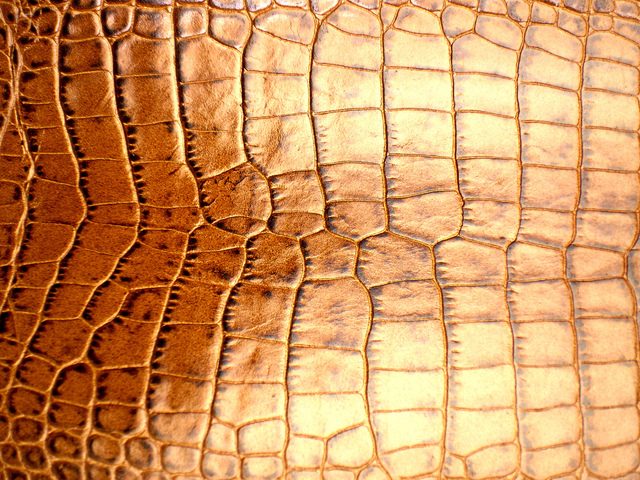
Travel to Kenya to get to know the crocodiles
Skin
High-quality crocodile skins that meet the standards and requirements of luxury brands go to well-established tanneries in Singapore, Europe and Japan that deal with the highest quality crocodile leather. Low-grade skins go to other Far Eastern countries, where they make non-branded leather accessories out of it. Between the superbly crafted products and the most ordinary ones, the range of quality and prices are as diverse as the type of leather available. This distinction is good because crocodile leather products is affordable and accessible to more people when they come in different price range.
Leather
The skin of Kenyan Nile crocodiles is highly sought out for making high-quality leather, which is considered as one of the most expensive and exotic leathers in the world. It is unique due to its elegant patterns and colors, which give it a subtle allure. The greatest advantage of crocodile leather is its versatility. Depending on the positions and sizes of the leathers, appropriate products will be crafted using almost all of the leather so as to shrink wastage. Apart from its stylish glimmer, its texture boasts a plethora of applications. Hides are used to make several fashionable accessories including handbags, belts, apparels, wallets as well as upholstery for furniture and cars that give designs a luxurious appearance with strength and durability. It has a prominent place in the lines of most global upmarket brands such as Vuitton, Versace, Gucci and Burberry. Although crocodile leather fashion is seasonal, the actual goods rarely lose its value due to scarcity, source and demand, not to mention the timeless craftsmanship required to produce a finished hide for production uses.
Scarcity
As with all luxury items, dearth of crocodile leather is a major factor in determining its value. Scarcity does not just mean rare supply. It is also the highly specialized tanning facilities and tools as well as lack of enough people with proper knowledge to produce a finished hide. Availability of hunters and farms or the shortage of them and the limitations of skin size are all determinants that affect its scarce nature. Due to these reasons, the supply of total skins available globally will always remain small. Its rarity implies that products made of crocodile skin will never be mass market.
Source
Source of crocodiles is a major factor that influences their value. Crocodiles are wild-caught or farmed. For farmed crocodiles, the bigger they become, the riskier it is to take care of them. They become increasingly aggressive since the reptiles are, by nature, predators. Often, the big crocodiles must be in their pens and rooms. As it grows to full maturity, the amount of food they consume also increases exponentially, and it can often consume twice the amount as the previous year. On the other hand, wild-caught crocs do no need care and feeding, they are at a significant risk in their natural habitat of experiencing trauma where they develop inconsistencies and scars in the skin. A crocodile of at least three years without any scars is a rare find.
Demand
The third factor that determines the value of crocodile leather is the increased demand for sizeable skins, which fetches a high price. It can only come from a crocodile that is raised or found to be more than three years old. Crocodiles get easily stressed, and when they are under pressure, it shows as flaws in the skin. To avoid that, farmers take great care of their crocodiles at least until the age of three. And that is the price people pay. Large size skins without any stitches are the ones used to make big items. Such big item products made of one full stretch of skin with no sewing has the highest demand. And the price goes up with the size of the hide.
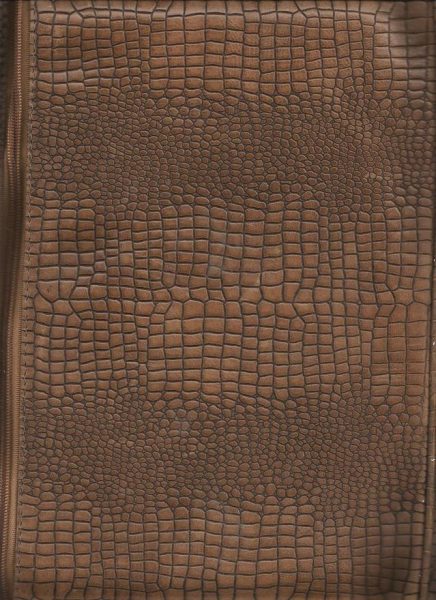 Craftsmanship
Craftsmanship
Crocodile leather products are highly ranked eye-catchy crafts of extraordinary meticulousness and skillfulness. Once the crocodile skin is detached, it is preserved, dyed with chemicals and tanned in many textures and colors, leaving many possibilities for adding luxury to them. After that, the skin goes through a polishing phase. And finally, a piece of beautiful leather emerges which is ready for production. Owing to such process of handmade craftsmanship, they are original too. Therefore, many people are fond of the products.
Cuts of leather
Crocodile leather is a processed and tanned skin. The leather comes in two cuts. A belly cut or belly leather is the term given to the entire underside of its belly, tail and chin. It is tender, pliable, smooth, flat and soft. It is the most expensive piece of skin that is popular with wallets, purses, watchstraps, belts, handbags and upholstery. A back cut or back leather is the piece of skin running down its spine from behind the head to its tail, including four rows of raised osteoderms. The back of a crocodile bristles with horny, bone-hard scales. This skin is popular in applications and trimmings where the rough texture is desired such as briefcases, big bags, barbed belts, horn back boots or products with a rough surface. The tail, legs, head and many other body parts contribute unique styles, creating a diverse palette.
Measurement
Crocodile skins are measured by the width of the largest portion of the body of the crocodile, at the second bone on its either side. The pattern width does not determine the value of a hide. Hence, it is important to look at the measurement of the overall skin when purchasing the leather.
Grading
Crocodile skin classification determines the price of the leather. Grade A hide, or top-quality skins are of the best leather, which will be free of defects. Grade B leather possesses inconsistencies and flaws. However, there is usually a portion that is suitable for smaller applications like trims, wallets and hats. Some defects that affect the grading include scar tissue, discoloration or uneven dye and holes of any kind such as tanning errors.
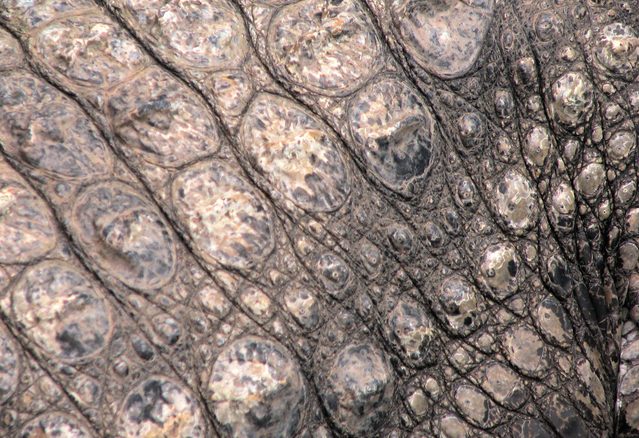 Manufacturing process
Manufacturing process
Leather may be the simplest manufactured material in prehistoric times. But modern leather manufacturing, using natural and synthetic tans and a variety of treatments, is a complicated procedure. The chemicals and equipment used are subject to variation and the exact procedure changes between tanneries. Surely amateurs can make reasonably good leather because the core operations are standard. However, making the best crocodile leather is a long and skilled procedure. Also, the excellent features of the leather are due to finishing to the optimum combination of required moisture, oil content, thickness, appearance and suppleness. Hence, the raw material used must be worthy of the investment in labor and skill. If the raw materials used are of inferior quality, then a different operating procedure will be used. Crocodile leather passes through many convoluted stages with routine treatments such as cleaning, chemical treatment, neutralizing, bleaching, pre-tanning, tanning, finishing, drying and coloring.
Cleaning
The initial preparation of crocodile skins for tanning happens in the beam house. It is first soaked to clean and to remove salt and preservatives. It allows the skin to dissolve out some soluble proteins and to reabsorb its lost water. Inadequate soaking can cause problems, but too much can rob it of desirable substance. Paddles are used to soak ossified skins and pits are used to soak those skins intended for a classic finish. Skins of similar type and size are treated in batches to ensure uniform soaking. They are then put on a shaving machine to stretch the skin and clean the flesh side.
Chemical treatment
The next process called liming takes two days in which they treat the skins with chemicals in pits, paddles or rotating drums. A traditional method is to use slaked lime in temperate climates, and sodium sulfide at higher temperatures. Some tanneries also include other chemicals such as degreasing agents and common salt. This process dissolves away the epidermis and scales, convert the fats into soaps, make dark pigments soluble and open up the skin structure in preparation for bleaching.
Neutralizing
During liming, the skins become strongly alkaline. Hence a partial neutralization is done using ammonium salts. Skins at this stage are sensitive to abrasion and can affect the condition, especially the swelling of fibers. Therefore, they require only occasional paddling. The skins remain immersed in enzymes, which act upon the hide proteins and give them the required softness, pliability and elasticity. Classic crocodile skins do not need much of this process, as they must remain firm for a smooth and perfect finish.
Bleaching
There are two stages involved in bleaching which occurs in a revolving drum. The first step uses potassium permanganate and the second stage uses sodium bisulfate. Each process takes less than an hour. Oxidative bleaching is preferable as it does not affect the fiber structure and allows a higher tear-strength.
Pre-tanning
Next phase is the pre-tanning preparation of skins using minerals. It is also called acid bath treatment and is done by suspending it in hydrochloric acid and given a slight agitation. This process takes several days.
Tanning
Fundamental to establishing and guaranteeing the prestigious appearance, elegance, quality and beauty of leather is the tanning process. The dermis of the crocodile skin contains interwoven fiber bundles, which in turn consists of collagen with a high tensile strength. The tannage coats the collagen fibers making them heat- and decay-resistant. The tanning agent determines the quality of the leather. With crocodile skins, chrome tans, as opposed to plant or vegetable tans, produces better results. An accurate control of chrome tannage gives uniform results and better properties. The skin gets its matte, glossy or metallic finish from tanning. Choosing between matte versus glossy versus metallic finish is one of personal preference. Natural pigmentation of the skin is bleached out during the tanning process, allowing the tanner to dye it any color. After three days of chrome tanning in drums, the skins transform into blue wet chrome leather. The industry term for this is ‘wet blue stock,’ and at this stage, they are chemically very stable. At this juncture, they can be left in the wet state on a rack, which can increase the bond between the corium fibers and the chrome-tanning agent. Then the tanned leather is shaved to a uniform thickness using a shaving machine. It shears the skins to less than 1mm in diameter. After shaving, a neutralizing process treats the leather in a drum of sodium bicarbonate for about an hour, which completes the tanning. It is then stored for many months in plastic sheeting. Leathers from different species of crocodile are tanned differently, even if worked in the same tannery.
Finishing
The finishing is carried out in a drum using synthetic tanning materials, at the end of which the color of the leather becomes light. It is a short process involving one and a half hours. Then they are fat-liquored again, which loosens the leather and penetrates it in the drum. Regardless of finish, the quality of the skin is the same.
Drying
Drying is an important process whereby the wet blue stock is drained of surplus moisture. Particular attention is given to ensure that the moisture is eliminated evenly and not in patches. After this, sorting of the leathers called ‘crust stock’ takes place in preparation for dyeing.
Coloring
The dry stock is wetted back by soaking in a suitable wetting agent. After that, they are prepared chemically for different colors. Coloring with a dye in the drum that takes a few hours is a very skilled operation that requires proper attention to evenness, light-fastness, saturation, color matching, etc. All colors come with longevity in mind and subtlety that the fashion trends demand.
Completing
After dyeing, a dry-shaving machine shaves the leathers giving it a domed or raised scale pattern. The high gloss finish occurs by using natural protein coatings together with synthetic seasonings so that they become permanently waterproof and hard. As a final step, they are glazed using a glazing machine.
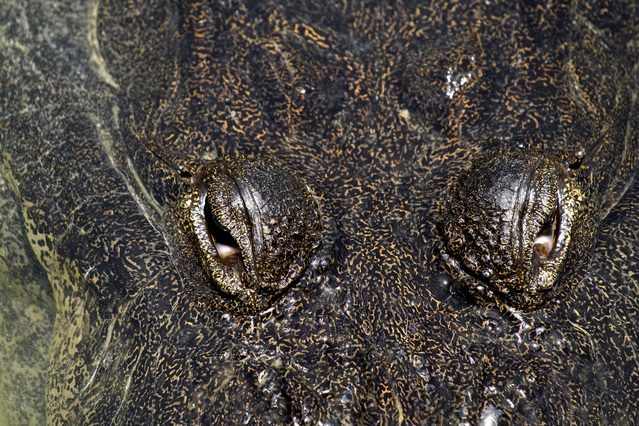 Real or fake
Real or fake
When it comes to distinguishing between fake and real crocodile leather, there are no hard and fast rules. It is ambiguous and depends on a combination of several factors. High-quality stamped leather can look like genuine crocodile skin. It can correctly reproduce the standard design. The incredible softness of fake leather makes it easily confused with real skin. Hence, it is easy to mistake stamped leather for a natural skin. A rule of thumb to follow is that a stamped leather product will be significantly cheaper than the same model in real crocodile leather. However, without touching and scrutinizing the leather in great detail, giving an objective and accurate judgment is extremely difficult. It takes years of experience to tell them apart. This expertise is hard to find, as it is a very specialized field. It is this rarity that makes crocodile leather a valuable and expensive item.
Fake leather
The natural design of fake crocodile leather looks too repetitive and regular. The structure and dimension of the scale forming the design looks too perfect too. And the thickness of artificial leather remains too uniform. Besides that, stamped leather is usually glossy while real crocodile skin is available both in matt and gloss versions and the effect always remains breathtaking and refined.
Genuine leather
Minor crocodile skins, whose skin is still malleable and soft, are used to manufacture original items. A medium-sized item would require more than one piece of skin. Bear in mind, though, that the look and appearance of authentic crocodile leather can depend on many factors.
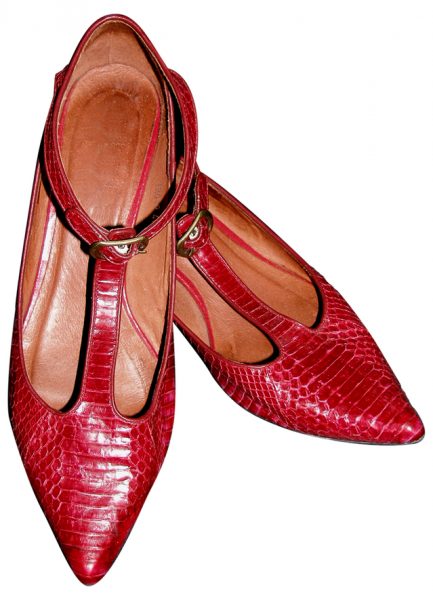 Aftercare
Aftercare
Crocodile leather is very fragile that requires delicate care to stay in shape. Restrict excess movement of accessories that may scuff it up. Moreover, contaminants seep into the pores from everyday use, depleting the natural oils. So, it is recommended to clean and condition the leather at least once a month. Cleaning and conditioning crocodile leather is relatively easy.
Cleaning
Moisture in the atmosphere can cause crocodile leather to dry out quickly after which it can develop spots and eventually crack. Even if it is not subject to harmful exposure, it will dry out over time. Hence it is important to clean the entire surface by gently wiping over it with a white cloth. Then use another dry cloth to dry it off as much as possible. Allow it to dry in a cool, dry indoor location away from direct heat and sunlight. This procedure is also used if the leather gets wet.
Conditioning
As is the case with cleaning, it is highly advisable to condition the leather with a compatible leather conditioner specifically designed for crocodile leather care. Equally important is also to always test the conditioner first before using it by applying small amounts. Do not rub the conditioner too much into the stitching but rub it gently and give it an even coat using a soft microfiber cloth, making sure to wipe off any excess. Allow it to penetrate the leather and dry naturally. Afterward, buff the surface with a clean cloth and allow it to dry in a cool indoor place. Beeswax tends to work well with crocodile leather. Neutral leather shoe-cream can also nourish the skin.
Grease stains
Use lanolin-based leather cleaner to get rid of greasy stains. But test it first. Oil stains can also be eliminated by placing cornstarch over the spot and allowing it to absorb. Avoid rubbing the cornstarch, as the contaminants may only get deeper into the leather. After a few hours, brush off the powder with a clean and dry rag. Avoid using actual brushes or paper, as they may scratch the surface of the leather.
Storing
After cleaning and conditioning the leather, make sure to keep it in a suitable place away from plastic bags. Do not put it under other objects as they may stress or fold the leather but store it inside a box or dust bag with minimal exposure to contaminants.
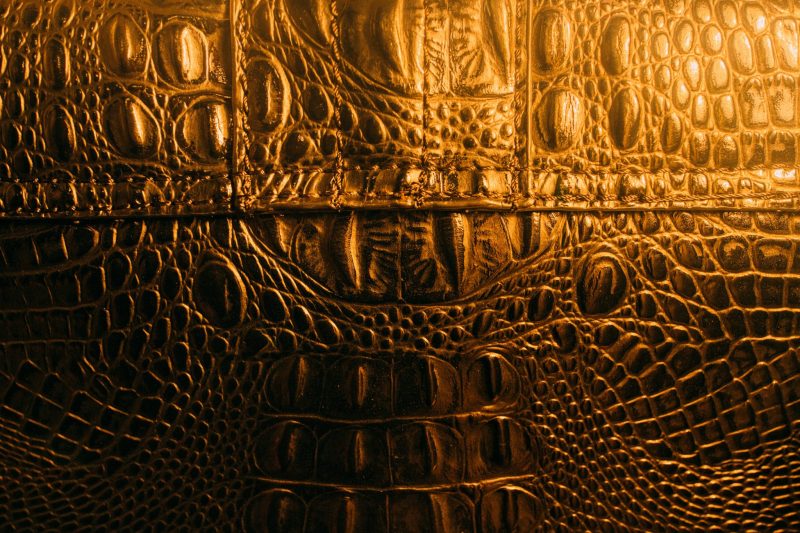 Crocodile skin producing countries
Crocodile skin producing countries
Some countries produce crocodile skin as well as process the hides to leather. In other words, they have crocodile farming facilities and are also equipped with the infrastructure to transform the skin to leather. But some other countries that supply raw crocodile skins such as Kenya are in a dilemma. They ask whether it would not be profitable to tan them locally in their country rather than export them in wet salted state. When it comes to owning a leather processing business the solutions available at their disposal are either to do partial leather processing or to run a pickling plant. Both of these opportunities seem lucrative. Nevertheless, it is hard if not impossible to answer the question of whether to process the leather in house or to export the skin in wet state merely because each has significant challenges.
Partial leather processing
The first option available to a crocodile skin producing country is to process and export semi-finished leather. When deciding to export crocodile skin for tanning, some crocodile skin producing countries mull over whether to do part processing in their countries and then sell them so that the tanner still has some processing control and options open. There is also an advantage to the tanner if pre-tanning operations have been done elsewhere because they eliminate the expensive problem of effluent disposal. There are only a few established reptile tanneries in the world because of diminishing supply. These companies have come to terms with the pollution issue and prefer to buy the skin in wet salted state because they can assess the quality of the leather. With partly processed hides, they cannot inspect the quality. Moreover, certain pre-tanning processes influence subsequent treatments of the skin. A tanner prefers to control every operation of the leather-making process.
Viability of pickling
The second option is to run and operate a pickling plant. A tanner may be prepared to buy pickled skins provided that the processing is carried out to their satisfaction. A small pickling plant requires only a modest investment. A 150-square meter building can house the entire facility. Drums, soaking vats and paddles could be available locally. A total of 12 people would need to be employed. Small wells can be used to treat and settle brine sludge for waste disposal. However, a steady and reliable supply of clean water and electricity is essential. Additionally, a fleshing machine would be available overseas, and this would be the most expensive equipment. Financial projections would have to include local costs and availability of expertise for the first year of operation. Estimating the market prices for pickled skins should take into consideration the preference of tanners for wet salted material. After all, the extended storage life of pickled skin could be an advantage to the producers as it gives them more bargaining power in negotiating the sales.
Capital investment
Operating a crocodile farm has commercial potential because its skin is very much in demand. However, rearing crocodiles for trading purposes is a complex industry. Setting up a successful crocodile farm, although lucrative, is quite an expensive business, requiring a minimum of $2 million to set it up. And it can take over five years before harvesting the initial stocks of the crocodile. The time and money is needed until the crocodiles are large enough for selling their meat or hides in the international markets. Meanwhile, the maintenance costs are very high. Usually larger farms are more profitable and viable than smaller farms. Moreover, the business requires lots of expertise, patience and confidence before it can make a profit. So, success in this business depends on significant capital and experience in crocodile behaviour, biology and nutrition. But even then, financial success is not guaranteed.
Trade policy
Crocodile farming is open to all. However, international trade of crocodile skins in the market is strictly regulated. Rules and regulations vary from one country to another. Hence, it is important to consider the production policy of host countries. The legalities of exporting and importing crocodile leather also differ. For example, in the United States, crocodile leather can be legally exported and imported in compliance with Cites regulations. But trade restrictions apply to some other countries. For example, crocodile from Thailand, Cambodia or Vietnam is strictly outlawed for possession and sale or importation to the United States regardless of whether it is in compliance with the regulations. Sadly, sellers in these countries still try to ship and sell crocodile leather to ignorant Americans and thereby commit criminal actions by attempting to trade these skins.
Due diligence
Countries that export wild crocodile resources must prove that there is no threat to the survival of crocodiles. It typically involves monitoring of wild crocodiles in compliance with the existing regulation and the use of products in trade. Nowadays, due to high-quality demands and industry regulations, skins do not meet the standards in the international market, which has helped to save the dwindling populations worldwide. Although there is a huge demand for Nile crocodile skin, the industry is quite vulnerable to economic changes. As it is an export-based industry, profitability relies on exchange rate. Crocodile farmers took a big knock during the economic recession.
License
Every person planning to keep and raise crocodiles in Kenya should apply for a farming license, through the regional office of KWS – Kenya Wildlife Service. Building a suitable commercial environment for breeding and growing the crocodiles would make it easier to get the permit.
Expertise
The modern leather manufacturing process is very complicated. Merely obtaining a commercial crocodile farming license and building the necessary infrastructure is hardly enough to make it a viable business. It needs people with special expertise and in-depth industry knowledge about crocodiles because caring for the reptiles is a huge part of the operations. And this can only come from abroad at great expense. Perhaps after considering the processes involved in tanning and finishing of skins as well as the production policies of countries, the challenge may become apparent. It is highly advisable that the entrepreneur volunteers in a crocodile farm for a couple of months to get a good grasp of how to run the business. Owners of the farms are always happy and proud to share information about their rearing business.
Tannery for multipurpose
A few countries that produce crocodile skins are disadvantaged because of the tropical climate. But the good news is that it is possible to overcome this hurdle. However, the question is not whether the business operations are feasible or not but whether it is financially worth. The answer depends on the type of tannery and the intended market. So, what are the solutions? Although seasonal fluctuations do not pose problems because of the availability of adequate storage facilities in pickling plant, a short fall over an extended period could result in the plant lying idle for most of the year. Furthermore, it is evident that a reptile tannery cannot be put to use for other purposes without modifying it. Perhaps, a multi-purpose tannery would be ideal if countries can find down market manufacturers to sell less expensive skins. It would also provide more flexibility for optimum scale of operations and a broad base for the investment.
Up-market leather products
As more people join middle and upper classes, demand for up-market products will continue to rise, which presents a unique opportunity for producers of crocodile skins. Expensive crocodile leather items are superbly crafted popular articles that cater to upmarket segment. Apart from quality, manufacturers are also concerned about the ease of placing repeat orders for an identical unit or the availability of same product with different colors at short notice. It would be impossible for a producing nation to break into this tiny niche market for high-class crocodile leather when the manufacturer has a choice of a long time trusted supplier.
Down-market leather products
Leftover crocodile leather that cannot be used to make valuable items is inferior leather. They are used to manufacture and sell poorly made goods to a vast majority of tourists in many places. A crocodile skin producing country may be better off finding this in-between market that would fetch a much better return on investment rather than tanning wet-salted skins. The species of crocodiles involved determines the value for the world of fashion. But for the down market, it is far less important. Moreover, curio vendors buy crocodile teeth, skeleton and skull. Also, the farm can be used as a sanctuary and visitors can be charged an entry fee.
Building structure
Choose an area where wild crocodiles live naturally. A construction of 800 square feet for cooler, freezer and storage and a grow-out building of 5,000 square feet are ideal. Run hot water pipes or electric heater coils through the concrete because crocodiles require a consistent temperature. Always try to keep the crocodiles stress free. Insulate the building to minimize outside noise as it can create stress and agitate the crocodiles. A stressed crocodile develops brown spot disease, which creates discolored spots on their hides, and it can reduce the value of the leather.
Manner of feeding
Another important factor to consider is the manner of feeding the crocodiles. Healthy feeding is a must. Do not overfeed them as it can cause gout in crocodiles. As an investor, it is recommended to familiarize with such intricacies of raising crocodiles in the farm.
Mamba crocodile farm
Crocodiles need proper care and treatment not only for the sake of the reptiles but also for the safety of the handlers. There is no such thing as a tamed crocodile. They are as nasty in captivity as they are in the wild. Their attacks are sudden and unpredicted. A visit to the Mamba crocodile farm in Nairobi gives a chance not only to observe the crocodiles but also to learn from the caretakers about how they avoid getting caught by these sly attackers.
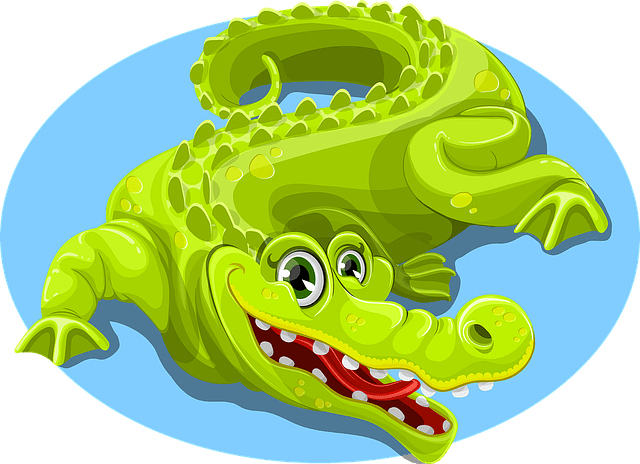 Crocodile spirit symbol
Crocodile spirit symbol
Crocodiles have played an important part in human culture and an essential part in the earliest spiritual lives of native people in many countries. Some people worship them as supernatural creatures while some others use them for decorative or medical purposes. In Christian antiquity and according to the Bible, it is the devil and a monster of chaos. Hence, early Christians during the middle ages chained stuffed crocodiles on church walls representing chained devil. Thousands of years ago, armours for warriors were designed using crocodile skins. When soldiers wore them, they took on the spirit of toughness and trusted their primal instincts making them go deeper for answers. The symbol also forces them to know themselves, to find their inner powers and to understand that life and dreams do not reside outside but within oneself. Nubian fishers, to this day, stuff them and mount them over their doorsills to ward off evil.
Unflattering personality traits
Crocodile signifies unflattering personality traits such as aggressive attitude, short-temperedness or even one’s tendency to display insincerity and false emotions by shedding crocodile tears. A notable feature of people who have crocodile as their animal totem is the gift for being their authentic self at all times. They are usually in touch with the real emotions in any situation. What they project emotionally allows others to be their selves. It is not always pleasant or easy to deal with these true selves. One must exercise lots of patience. But by channelling empathy and seeking clarity and guidance in the chaotic emotions of other people, they have an accurate understanding of what is being expressed. As a result, they are talented healers in the emotional realm. They accept this responsibility and behave accordingly. It is a well-established fact that crocodile symbol has not faded but still exists in modern times too. The symbol is one that is also very well famous for its many other attributes apart from durable toughness and personality traits.
Meaning in symbol
The significance of crocodiles concerns intense spiritual realms than most other animals. For example, because these reptiles live in both water and land, they represent the duality of consciousness and unconsciousness as well as the emotional and rational. Both are equally influential and relevant, although it is not easy to balance them appropriately. To dream a crocodile symbolizes freedom, power and strength. It also cautions of hidden danger and means someone is giving bad advice and is trying to direct towards poor decisions. At the most basic level, crocodile animal totems collectively remind us that we cannot always be docile and gentle but must also be in possession of characteristics like courage, patience, honour, speed and fear. Apart from these things, they also give other good pieces of advice.
Chronic digestive problems
Concealing themselves in water and mud, the crocodile waits patiently for its prey. It eats any animal it can get hold of and if unable to swallow, will tear it into pieces. But it doesn’t eat unnecessarily. It is a reminder to be mindful of the food and to not under eat or over eat but to absorb it thoroughly as digestive problems are common amongst those whose animal totem is crocodile.
Highly evolved senses
Crocodile has acute senses, especially highly developed vision allowing it to see well when it hides underwater at night. The eyes are located high on its head, enabling it to stay pretty much below water yet see above it, urging us to exercise hyper vigilance by developing our senses as well.
Sharp clairvoyant skills
Crocodile represents precision of motion and agility. By utilizing its ability to camouflage itself, it slowly pushes forward without moving a muscle, before pouncing, thereby achieving major success as predators. The croc knows when to hide and when to take action. Symbolically, this denotes clairvoyant abilities. From this, it advises us to wait for the opportune moment to strike and alerts us to be patient before making our decisions.
Spirit precedes body
The symbolic meaning of crocodile totem encompasses the ferocity and fury of the most primal, unbridled and untameable creative forces of the body, which include reproduction, survival and the passing of strength to the young. These energies tell us that we should seek to conserve our precious lives at all costs. But, most importantly, this reptile teaches us that it is the survival of spirit that gives strength and life to the body. In other words, the body suffers if the spirit suffers.
Period of regeneration
Crocodiles are symbols of wisdom and the protector and keeper of all knowledge. Therefore, this ferocious beast signifies a new beginning of the term of renewal and growth. Take time to integrate the changes in life. Look for opportunities to absorb and ingest new knowledge and wisdom if a crocodile has swum into the life. Use breathing techniques to keep balanced during this time of change.
Connection to water
Life began in water. Crocodile thrives and lives mostly in the deep, mysterious realm of swampy water near its primal source of origins. When it wanders there, it forms a connection with nature and tunes into these energies of growth from which its life came 50 million years ago. So, it did not need adaptation and had barely changed. It has inhabited the earth and survived in it with little evolution. It is due to this reason that crocodiles demand respect for the earliest beginnings. To have crocodile as one’s totem spirit animal is to flow with abundant waters of life itself. The crocodile connects to the spirit and primal instincts as well as remembers all of its past lives from the water. It is from water that it learns how to exercise hyper vigilance and receives all its clairvoyance skills. Water conveys genetic memory to the crocodile such as its long-lasting toughness and unflattering personality traits. These universal lessons are the crocodile spirit animal’s gift to its people.
To receive a colourful digibook about crocodile with videos, images and text, please fill out the following form or simply email us on safaris@safari-center.com

